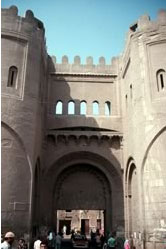
Late medieval Islamic history: Fatimid gate of Cairo Bad al-Futuh (1087 AD)
The Abbasid Empire
In 750 AD, it seemed like the Islamic Empire would last a thousand years. The Abbasid caliphs ruled a giant empire. It stretched from Morocco to Afghanistan. Their capital was at Baghdad in modern Iraq. Baghdad was also a center of scholarship and trade. The Abbasids kept control until the early 900s – that’s a run of more than two hundred years, which isn’t bad for an empire. Over the next few centuries, the Islamic Empire broke up into smaller and smaller pieces. We can see the beginnings of today’s countries. But then… well, you’ll see.
The Abbasids
Medieval Islamic economy
Earlier Islamic history
All our Islamic Empire articles
Fatimids in Africa
But then the empire split into two caliphates (KAL-if-fates). First the Fatimid dynasty took over all the Islamic land that had once been in the Roman Empire: Egypt, North Africa, Israel and Syria, and the Arabian Peninsula. The Abbasids still ruled the half that had once been the Sassanian Empire.
The Fatimids
Fatimid architecture
Turks and Mongols
Then a second change began, possibly because of some sort of climate change. Turkish and Mongol people from Central Asia started to migrate south and west into both of these Islamic Empires. The Ghaznavids and the Seljuks – both Turkish groups – first came into the Abbasid empire as mercenary soldiers.
Ghaznavids in Iran
Who were the Seljuks?
Central Asian history
But in 962 AD, the Ghaznavids made Afghanistan and Pakistan an independent country under their rule. Then just after 1000 AD, the Seljuks also decided to rule for themselves. The Seljuks conquered the Ghaznavids. By 1055 they also took over Baghdad. And in 1071 they conquered Turkey from the Byzantines at the Battle of Manzikert. (That’s why we call it Turkey today.) Because of their start in Iran, the Seljuks spoke Persian, rather than Arabic or Turkish.

University of Fez, Morocco (1130s AD)
More people invade
The Islamic Empire’s weakness invited other raiders in. In 1096 AD, European Crusaders conquered a good deal of Israel and Lebanon from the Fatimids and plundered it.
The First Crusade
Saladin and the Ayyubids
Who were the Mamluks?
Africa’s Almohads
By 1200, two more Turkish groups, the Ayyubids (under Saladin) and the Mamluks, took Israel back from the Europeans. But more pieces broke away. The Almohads succeeded in forming an empire out of North Africa and Spain.
The Almohad empire breaks up

An inner courtyard of the Alhambra
During the 1200s, the Almohad empire in turn broke apart into even smaller pieces. In northern Spain, the kingdoms of Aragon, Castile, and Portugal defeated the Almohads in 1212, and conquered most of Spain by 1248 AD. In North Africa, the Almohad empire also split into three smaller kingdoms: the Hafsids in the east, the al-Wadids in the center, and the Marinids in the west. These kingdoms got rich as traders crossed the Sahara to the south and the Mediterranean Sea to the north. They sold gold and enslaved people to the north. And they sold manufactured things like clothing and glass dishes to the south.
The Hafsids
The Marinids
The Nasrids
Islamic North Africa
Then in the 1300s and 1400s, the armies of Aragon and Castile gradually forced the Almohads and then the Nasrids out of Spain, finishing up in 1492 AD.

Taqi al-Din in his observatory
The Mongols’ new empire
Back in the eastern part of the Islamic Empire, the Mongols invaded in 1260 AD – were they driven by the beginning of the Little Ice Age? – and conquered it from the Seljuks. The Mongols created another huge empire, but this one had different borders.
Genghis Khan and the Mongols
The Yuan Dynasty in China
The Black Death
Timur rebuilds the empire
It covered the old Sassanian Empire and Turkey, but also most of Central Asia, Pakistan, part of northern India, and China. The Mongols held their empire together for almost a hundred years, until the Black Death caused a collapse in the 1340s AD. Even after that, the Mongol Timur rebuilt part of the Mongol Empire. Timur (or Tamerlane) ruled from Turkey all the way across Russia to Afghanistan and northern India. But Timur’s empire collapsed when he died in 1405 AD.

Suleiman Mosque, Istanbul (1500s AD)
The Ottoman Empire
In the 1400s, the Ottomans (successors to the Seljuks) began to build themselves a third big Islamic Empire. Like the Fatimids, the Ottomans focused on taking over the Roman half of the Islamic Empire. The Ottomans took Constantinople (modern Istanbul), Greece, and Eastern Europe from the Byzantines in 1453 AD. In 1464, they conquered the Marinids in Morocco.
The Ottoman Turks
The end of the Roman Empire
Then in 1517, the Ottomans conquered Syria, Israel, and Egypt. And in 1574, the Ottomans conquered the Hafsids in North Africa. So in these 800 years of late medieval Islamic history, several big empires rose and fell, but in the end, most of the Islamic world was still united.
Did you find out what you wanted to know about late medieval Islamic history? Let us know in the comments!
Learn by doing: eat an orange
More about the Ottoman Empire
Bibliography and further reading about the Islamic Empire: